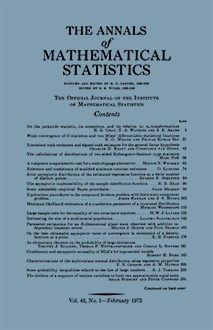Abstract
This paper is divided into two parts. The significance tests investigated in Part I concern the population mean and are based on the quantity [(sample midrange)-(hypothetical mean)]/(sample range). The case in which the observations are a sample from a normal population is considered in detail. The tests investigated are summarized in Table 1. These tests are found to be very efficient for small samples (see Table 4, power efficiency is defined in section 3). An investigation of several extremely non-normal populations using the values of $D\alpha$ obtained for normality indicates that the significance level of the range-midrange test is not very sensitive to the requirement of normality for small samples (see Table 6). Also the tests of Table 1 can be applied without computation through the use of an easily constructed graph (see section 4). These properties suggest that the range-midrange test is preferable to the Student $t$-test and the analogue of the Student $t$-test using the sample range (see [1] and [2]) whenever the sample size is sufficiently small. Use of the range-midrange test for the case of normality was proposed by E. S. Pearson in [3], where properties of the test were experimentally investigated for the normal and certain non-normal populations. In Part II several significance tests for the mean are developed which have a specified significance level for the case of a sample from a normal population but whose significance level is bounded near the specified value under very general conditions, one of which is that the observations are from continuous symmetrical populations. Some of these tests are range-midrange tests. Table 2 contains a summary of the tests and their properties ($x_i = i$th largest observation, $i = 1, \cdots, n$; conditions $(D)$ are given in section 7).
Citation
John E. Walsh. "On the Range-Midrange Test and Some Tests with Bounded Significance Levels." Ann. Math. Statist. 20 (2) 257 - 267, June, 1949. https://doi.org/10.1214/aoms/1177730034
Information





